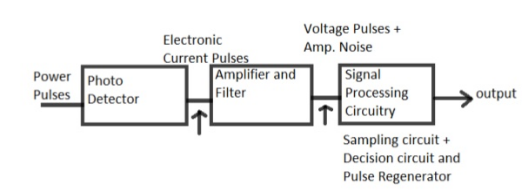Matlab based Simulink Modelling and Performance Analysis of Free Space Optical Communication System: A Review
Main Article Content
Abstract
Free Space Optical communication is extended and compatible technique with the radio frequency technology. FSO provides BW spectrum that is in terahertz besides this speed of the data transfer is very fabulous. Due to these advantages FSO is becoming very popular communication technology for satisfying the growing demand of bandwidth traffic mainly for the long-distance communication. FSΟ communication has achieve important attention between various researchers for more BW and to transmit data securely in various domains. There must be integrated environment for FSΟ system which have robust mechanism to overcome signal loss under turbulence condition varies from medium to strong. During data transmission BER must be minimized otherwise significant information may be lost. There are various mechanism to control BER against various parameters like path loss factor, distance and atmospheric condition. After investigation various research paper, a robust
Article Details

This work is licensed under a Creative Commons Attribution-NoDerivatives 4.0 International License.
References
M. A. Al-Habash, L. C. Andrews, R. L. Philips, "Mathematical model for the irradiance probability density function of a laser propagating through turbulent media," Optical Engineering, vol. 40, no. 8, pp. 1554-1562, Aug. 2001.
X. Zhuand, L. M. Kahn, "Free space optical communication through atmospheric turbulence channels," IEEE Trans. Communication, vol. 50, no. 8, pp. 1293-1300, Aug. 2002.
X. Zhu, L. M. Kahn," Performance bounds for coded free-space Optical communications through atmospheric turbulence," IEEE Trans. Communication, vol. 51, no. 8, pp. 1233-1239, Aug. 2003.
M. A. Naboulsi, H. Sizun, and F. de Fornel, "Fog attenuation prediction for optical and infrared waves", Optical Engineering, vol. 43, no. 2, pp. 319-329, Feb. 2004
X. Wang, K. Kitayama, "Analysis of beat noise in coherent and incoherent time-spreading OCDMA," IEEE/OSA, Journal of Light wave Technology, vol. 22, no. 10, pp. 2226-2235, 2004.
T. H. Shake, "Confident performance of encoded optical CDMA", IEEE/OSA, Journal of Light wave Technology, vol. 23, pp. 1652- 1663, 2005.
A. Ahmed and S. Hranilovic, "Outage Capacity Optimization for Free-Space Optical Links with Pointing Errors," IEEE, Journal of light wave technology, vol. 25, no. 7, July 2007.
V. Jyoti and R. S. Kaler, "Performance analysis of one-dimensional and two-dimensional codes in optical Code division multiple access system", Department of Electronics & Communication Engineering, Thapar University, Punjab, India, 2009.
H. Henniger, O. Wilfert, “An Introduction to Free-space Optical Communications”, Radio Engineering, Vol. 19, No. 2, June 2010.
Ashish Kumar, Aakash Dhiman, Devender Kumar, Naresh Kumar, “Free Space Optical Communication System under Different Weather Conditions, IOSR Journal of Engineering (IOSRJEN), Vol. 3, Issue 12, ||V2|| PP 52-58, (December. 2013).
Ritesh A. Jadhav, Dattatraya S. Shitole, “Fiber Optics Communication and Applications”, International Journal of Innovative Research in Engineering & Science, ISSN 2319-5665, Vol. 4, Issue 2), (April 2013).
F. Idachaba, D. U. Ike, O. Hope, “Future Trends in Fiber Optics Communication, Proceedings of the World Congress on Engineering. London U.K, Vol 1, WCE 2014, July 2 - 4, 2014.
B. Priya, “Performance Analysis of SACOCDMA-FSO System Using MD Codes”, International Journal of Hybrid Information Technology, Vol.8, No. 5, pp. 187-194, 2015.
M. Singh, “Simulative Analysis of 10 Gbps High Speed Free Space Optical Communication Link”, International Journal of Future Generation Communication and Networking, Vol. 9, No. 3, pp. 139-144, 2016.
M. Bouhadda, F. M. Abbou, M. Serhani, F. Chaatit and A. Boutoulout, “Analysis of dispersion effect on a NRZ-OOK terrestrial free-space optical transmission system”, Journal of the European Optical Society-Rapid Publications, Society-apid Publications, 12:18 (2016).
D. Jain, Dr. R. Mehra, “Performance Analysis of Free Space Optical Communication System for S, C and L band”, 2017 International Conference on Computer, Communications and Electronics (Comptelix) Manipal University Jaipur, Malaviya National Institute o/Technology Jaipur & IRISWORLD, July 01-02, 2017.
Satea H. ALNAJJAR, Ammar A. Noori, and Arwa A. Moosa, “Enhancement of FSO Communications Links Under Complex Environment”, Photonic Sensors, 2017, DOI: 10.1007/s13320-017-0336-1
Simran Kaur, Priyanka Bhardwaj, “Performance of FSO Communication in the Atmospheric Turbulence for Various Modulation Schemes”, International Journal of Engineering Trends and Technology (IJETT), Volume 55 Number-3 January 2018.
T. Umezawa, T. Sakamoto, A. Kanno, A. Matsumoto, K. Akahane, N. Yamamoto, T. Kawanishi, “25-Gbaud 4-WDM Free-Space Optical Communication using High-Speed 2D Photodetector Array”, Journal of Light wave Technology, 2018.
Varun Srivastava, Abhilash Mandloi, Gireesh G. Soni, “Utage probability and average BER estimation of FSO system employing wavelength diversity”, Optical and Quantum Electronics, 51:229 (2019).
M M. Hassana, G M Rather, “Free Space Optics (FSO): A Promising Solution to First and Last Mile Connectivity (FLMC) in the Communication Networks”, I.J. Wireless and Microwave Technologies, 4(1), 2020.
A. Thakur, A. Gupta, H. Singh, S. Bakshi, R. Goyal, G. Singh, “Performance evaluation of SS-FSO communication system incorporating different line coding”, Optical and Quantum Electronics, volume 53, Article number: 330 (2021).
D. Arora, H. S. Saini, V. Bhatia, J. Kaur, “Enhanced Spectrum Slicing: Wavelength Division Multiplexing Approach for Mitigating Atmospheric Attenuation in Optical Communication”, Optical and Quantum Electronics, Volume 54, Article number: 258 (2022).
Q. Yang, L. Tan and J. Ma, "Doppler characterization of laser inter-satellite links for optical LEO satellite constellations", Optical Communication, vol. 282, no. 17, pp. 3547-3552, Sep. 2009.
D. Bhattacherjee and A. Singla, "Network topology design at 27000 km/hour", Proc. 15th Int. Conf. Emerg. Netw. Experiments Technol., pp. 341–354, 2019

